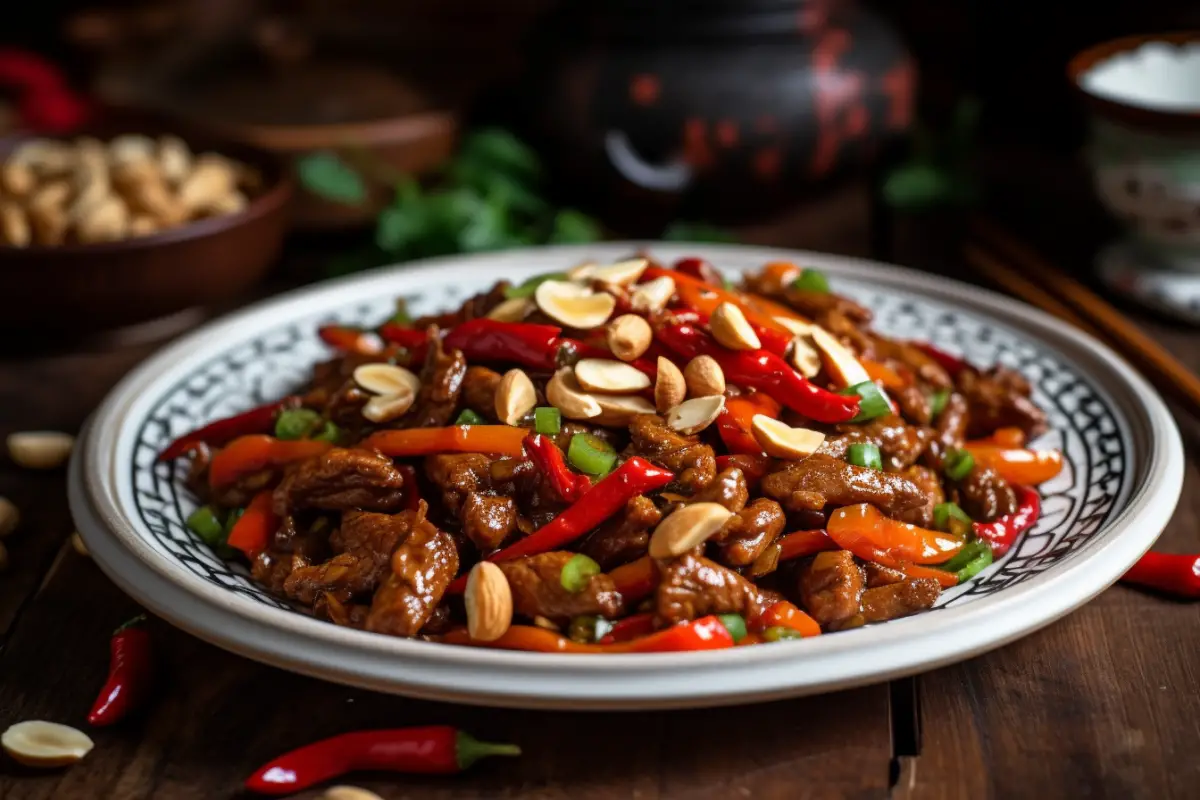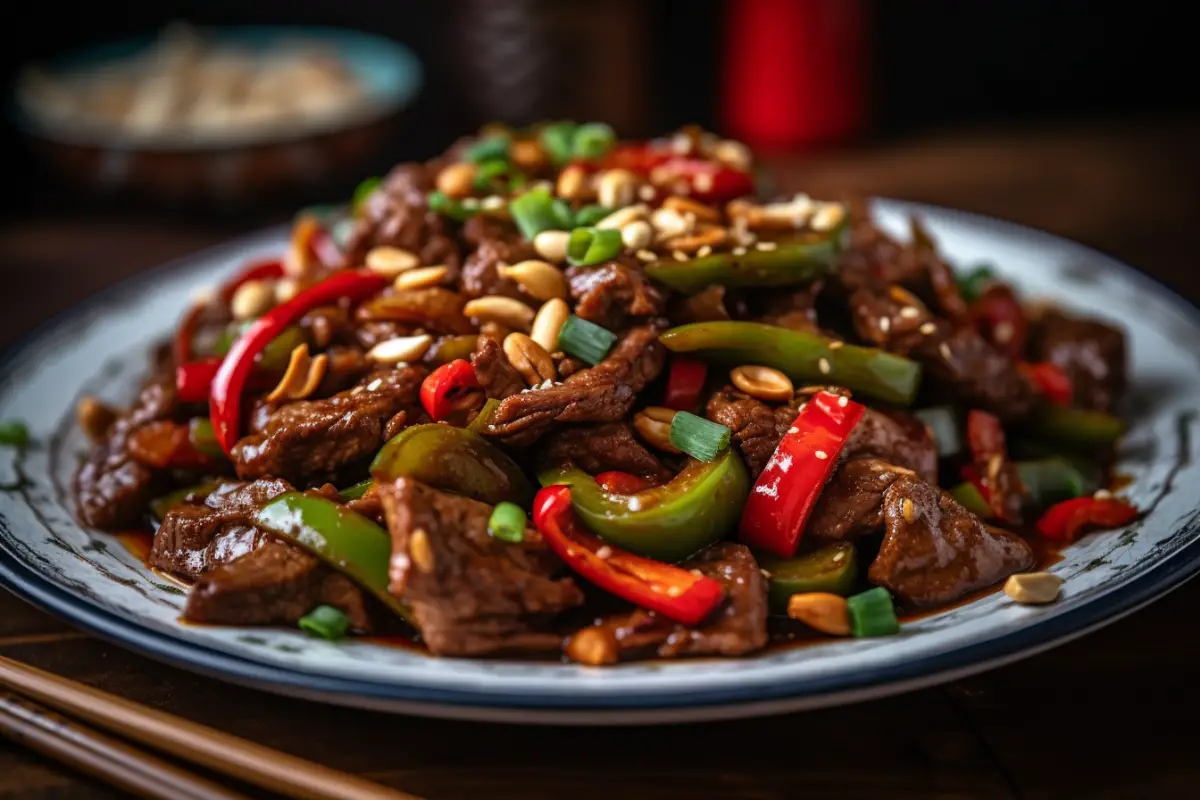Kung Pao Beef is a delightful fusion of spicy, savory, and slightly sweet flavors, rooted in Szechuan cuisine. Known for its perfect blend of tender beef, roasted peanuts, and bold sauce, this dish has become a beloved staple in both traditional Chinese and Westernized cuisine. But what exactly is Kung Pao Beef made of? In this article, we’ll explore the essential ingredients, cooking techniques, and much more, so you can fully appreciate what makes this dish so irresistible.
The Origin of Kung Pao Beef
Szechuan Roots
The history of Kung Pao Beef traces back to the Szechuan province of China, known for its bold and spicy dishes. Originally, the dish started as Kung Pao Chicken, named after Ding Baozhen, a Qing Dynasty official whose title “Kung Pao” (Palace Guardian) lent its name to the dish. Over time, variations emerged, including the now-famous Kung Pao Beef.
Cultural Relevance
In Chinese cuisine, the balance of flavors—spicy, savory, sweet, and sour—is key. Kung Pao Beef captures this harmony perfectly, making it a celebrated dish in China and across the world. It’s not just a meal but a representation of Chinese culinary principles of balance and texture.
Influence on Western Cuisine
As Chinese cuisine spread globally, Kung Pao Beef underwent slight modifications to suit Western palates. Many restaurants began adding more vegetables and adjusting the spice level, yet the core flavors remained intact. This adaptation has made Kung Pao Beef a favorite on Chinese-American restaurant menus.
The Key Ingredients in Kung Pao Beef
The distinct flavors of Kung Pao Beef come from its combination of fresh ingredients, each playing a vital role in creating the signature taste. Here’s what Kung Pao Beef is typically made of.
Beef
The primary ingredient in Kung Pao Beef is, unsurprisingly, beef. The best cuts for this dish are ones that are tender and cook quickly. Common choices include:
- Flank Steak: This cut is popular for stir-fries due to its tenderness and ability to soak up marinades.
- Sirloin: A slightly more robust option, sirloin works well when sliced thinly and stir-fried over high heat.
The beef should be sliced against the grain to ensure it remains tender and absorbs the marinade effectively.
Vegetables
While beef is the star of the dish, vegetables add crunch, color, and enhance the overall flavor profile. The most common vegetables used in Kung Pao Beef include:
- Bell Peppers: These provide a sweet, crunchy contrast to the spicy sauce.
- Onions: Onions add depth to the flavor while balancing the sweetness of the bell peppers.
- Zucchini or Carrots (optional): These vegetables can be added for extra texture or to cater to individual preferences.
Peanuts
One of the key elements that Kung Pao Beef is made of is roasted peanuts. Peanuts contribute a crunchy texture and a nutty flavor that pairs beautifully with the spicy and savory components of the dish. For those with peanut allergies, you can substitute with cashews or leave out the nuts entirely.
Kung Pao Sauce
The rich, flavorful sauce is the heart of Kung Pao Beef. It’s a blend of ingredients that perfectly balances savory, sweet, spicy, and tangy notes. Here’s what goes into the sauce:
- Soy Sauce: The backbone of the sauce, adding a salty, umami flavor.
- Hoisin Sauce: Adds a hint of sweetness and depth.
- Rice Vinegar: Provides the necessary tang to balance out the sweetness and spice.
- Chili Paste: This is where the heat comes from, giving this Beef its spicy kick.
Chili Peppers
Spice lovers will appreciate the dried red chilies that are traditionally used in this Beef. These chilies add both heat and a slightly smoky flavor to the dish. Adjust the quantity based on your preferred spice level.
Marinating and Preparing the Beef
To achieve tender, flavorful beef, marination is a key step in making this Beef.
Importance of Marination
Marinating the beef helps to tenderize the meat while infusing it with flavor. A typical marinade for this Beef consists of:
- Soy Sauce: Adds umami and saltiness.
- Cornstarch: Helps to seal the juices in the meat while thickening the sauce.
- Egg White (optional): Often used in Chinese stir-fry dishes to tenderize the meat further.
Time and Technique
The beef should be marinated for at least 15-30 minutes to allow the flavors to fully penetrate. Slicing the beef thinly also ensures it cooks quickly, keeping it tender and juicy.
Cornstarch Slurry
Cornstarch plays a double role in this Beef. It’s not only part of the marinade but also helps thicken the sauce, giving it that glossy finish you expect from a perfect stir-fry.
Stir-Frying Techniques for Kung Pao Beef
The stir-frying technique is vital in achieving the perfect texture for this Beef. Done right, this technique locks in flavor and keeps the ingredients crisp.
The Art of Stir-Frying
Stir-frying involves cooking the beef and vegetables quickly over high heat. Here are the key points to keep in mind:
- High Heat Stir-Frying: Always cook the beef over high heat. This ensures it gets a quick sear, locking in the juices while creating a slightly crispy exterior.
- Avoid Overcrowding: Cook the beef in batches if necessary. Overcrowding the pan can cause the meat to steam rather than sear, resulting in a less desirable texture.
Cooking the Vegetables
To maintain the crunch of the vegetables in this Beef, they should be added after the beef has been removed from the wok. Cook the vegetables briefly, just enough to soften them slightly while keeping their bright colors and firm texture.
Variations of Kung Pao Beef
While the traditional version of this Beef is delicious as is, there are several variations you can try to suit your preferences.
Vegetarian and Vegan Options
If you’re looking for a meat-free option, you can still enjoy the flavors of Kung Pao by substituting the beef with:
- Tofu: Firm tofu works well in stir-fries because it holds its shape and absorbs the sauce nicely.
- Tempeh: For a firmer, nuttier alternative, tempeh is an excellent substitute.
Different Protein Options
Kung Pao dishes can be made with other proteins if you prefer something other than beef.
- Chicken: You can easily substitute beef with chicken breast or thighs.
- Shrimp: For a seafood twist, try adding shrimp to your Kung Pao stir-fry. Shrimp cooks quickly and absorbs the sauce well.
Serving Suggestions for Kung Pao Beef
Pairing this Beef with the right sides and garnishes can elevate the entire meal.

Rice or Noodles
The best way to serve Kung Pao Beef is over:
- Steamed White Rice: The neutral flavor of steamed rice complements the bold, spicy flavors of this Beef.
- Fried Rice or Noodles: For a heartier option, serve with fried rice or lo mein noodles.
Garnishes
Adding garnishes enhances both the flavor and presentation of the dish. Consider:
- Chopped Scallions: Adds a fresh, sharp bite.
- Sesame Seeds: Provides a subtle nutty flavor and a little crunch.
- Chili Flakes: For those who love extra heat, sprinkle some chili flakes on top.
Nutritional Information of Kung Pao Beef
While this Beef is packed with flavor, it’s essential to be mindful of its nutritional content.
Calories and Macronutrients
A typical serving of Kung Pao Beef contains:
- Calories: Moderate to high depending on the amount of oil and beef used.
- Protein: High, thanks to the beef.
- Fats and Carbohydrates: Moderate, primarily from the sauce and peanuts.
Healthier Variations
If you’re looking to reduce the calorie count or sodium levels, here are some tips:
- Lean Cuts of Beef: Opt for leaner cuts like sirloin to reduce fat content.
- Low-Sodium Soy Sauce: Use low-sodium soy sauce to control salt levels.
Common Mistakes to Avoid When Making Kung Pao Beef
Making the perfect Beef at home can be easy if you avoid these common mistakes.
Overcooking the Beef
To keep the beef tender, make sure to cook it quickly over high heat. Overcooking can lead to tough, chewy beef.
Burning the Chilies
While chilies are crucial for spice, burning them can create a bitter taste. Cook them briefly, just enough to release their flavor without charring.
Sauce Consistency
A good Beef sauce should be thick enough to coat the ingredients but not overly thick. Use cornstarch sparingly and adjust as needed to get the right texture.
FAQ Section
What is the difference between Kung Pao Beef and Mongolian Beef?
This Beef is spicy and includes peanuts and dried chilies, while Mongolian Beef is milder and sweeter, with a thicker sauce and no peanuts.
What’s the difference between Kung Pao and General Tso?
Kung Pao is spicier with roasted peanuts and dried chilies, while General Tso’s Chicken is typically sweeter and often deep-fried without peanuts or as much heat.
What’s the difference between Kung Po and Kung Pao?
Kung Po and Kung Pao refer to the same dish. “Kung Po” is simply an alternative spelling and pronunciation often used in British English.
Conclusion: The Perfect Balance of Flavors in Kung Pao Beef
Kung Pao Beef is a classic dish that perfectly balances savory, spicy, sweet, and tangy flavors. Made of tender beef, roasted peanuts, and a rich sauce, it’s a dish that you can easily adapt to your taste preferences or dietary needs. Whether you’re enjoying it at your favorite restaurant or making it at home, the bold flavors of this Beef never disappoint. Try different variations, pair it with your favorite sides, and enjoy the harmony of textures and tastes that make this dish a true culinary treasure.

